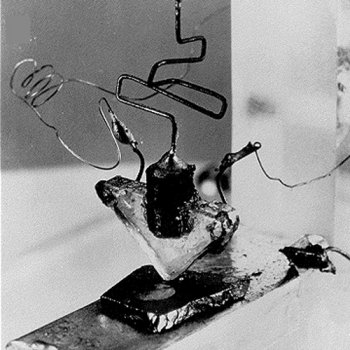Common menu bar links
Computers at Statistics Canada
Archived Content
Information identified as archived is provided for reference, research or recordkeeping purposes. It is not subject to the Government of Canada Web Standards and has not been altered or updated since it was archived. Please contact us to request a format other than those available.
Introduction
The Census and Statistics Act of 1905 ushered in the modern statistical era by creating a permanent Census and Statistics Office, known today as Statistics Canada.
Computers at Statistics Canada
1911
The Census consists of 13 questionnaires with 522 questions. The machinery used for tabulating census records from 1911 through 1942 is custom-built by A. E. Thornton, of the Bureau's mechanical tabulation staff.
1918
The Governor General in Council approves the use of mechanical appliances for all statistical compilations conducted by the government. Cards are punched at the departments themselves and then transferred to the newly created Dominion Bureau of Statistics for sorting and tabulation.
1919
The Department of Finance uses the Bureau's tabulating machines to compile income tax statistics.
1921
Compilation and tabulation are almost entirely mechanical, but productivity is greatly increased through the use of a new sorter-tabulator developed by Fernand Bélisle of the Bureau's mechanical tabulation staff. Three of these machines are built. They produce materials over 50 times as brief and concise as would have been possible with older equipment and save significant labour costs.
1932
R. H. Coats proposes the creation of a social and economic research body. He concludes that it "...would solve for some time to come, what had undoubtedly developed into one of the prime needs of government—that of keeping abreast of economic thinking, and of being continuously equipped with the materials required in the formulation of its broader economic policies, and of having more definitely recognized machinery to that end."
1949
The Mechanical Tabulation Division (MT) has 202 employees working with 173 units of tabulating equipment and 27 adding machines or comptometers. The division consists of a keypunch unit that serves several client divisions, a number of tabulating units geared to the special requirements of particular clients, and an auxiliary machine unit that supports the tabulating units. There are also calculating and adding machines and pegboards that perform simpler kinds of compilations directly from the completed statistical returns.
1950s
The U.S. Bureau of the Census used the UNIVAC computer to process the 1950 Census data. In 1951, a report stated "it would take at least 650 keypunch operators, working on 17 document punch machines during the week of peak Census processing, to produce a million punched cards completely edited and ready for tabulation." To realize productivity gains, and to pursue their interest in technical innovation, the Bureau acquired an electronic computing machine.
1960
Herbert Marshall, the Dominion Statistician, announces that the Bureau is getting ready to install an electronic computer. In 1960, an IBM 705 computer is acquired to process the 1961 Census. It is one of the biggest computers in Canada, and the heat generated by its 10,000 vacuum tubes has to be offset by two large air conditioners.
1962-1970
In 1962, Statistics Canada has one IBM 705, and one IBM 1401 with increased capacity. In 1963, an IBM 101 is added to the list. A year later, a second IBM 1401 is introduced. An IBM 360/30 replaces the first IBM 1401 in 1966. The 1966 Census is processed in the same manner as that of 1961. The major advances in these systems during this time are the Geographically Referenced Data Storage and Retrieval System (GRDSR) and the time series data bank, Canadian Socio-economic Information Management System (CANSIM). The IBM 360/30 is upgraded to an IBM 360/65 in 1969.
1971
The year 1971 marks the 100th anniversary of the first Census of the Dominion of Canada. The processing of population and housing questionnaires is carried out with 12 automatic tape-feed cameras provided by the United States Bureau of the Census. Data is transformed from film to magnetic tape by means of a new document reader, the Film Optical Sensing Device for Input to Computer (FOSDIC). Computer processing is carried out on an IBM 360/65 that is substantially upgraded to double the core memory (1,024,000 bytes). A large number of tables are produced as computer printouts and then microfilmed for distribution to users. In addition, because there is a demand for aggregated data in machine-readable form, a summary tape is produced.
1972
The IBM 360/65 is replaced by an IBM S/370-165 with a capacity of 1,536,000 bytes.
1973
The IBM S/370-165 now has a capacity of 2 million bytes, with an amazing 3.6 billion bytes disk storage. In addition, a mainframe, stand-alone microcomputers and minicomputers are also purchased.
1974
The mainframe capacity of the IBM S/370-168 is 3 million bytes and the disk storage capacity is 5.2 billion bytes.
1976
Statistics Canada builds a new computer centre in the Main Building. The mainframe at this time is the Amdahl 470/V6, with a disk capacity of 10 billion bytes.
1981
Statistics Canada's personal computer revolution begins in a small way when a few Xerox Star personal computers are acquired. Then, additional IBM-compatible personal computers are acquired.
1982
Mainframe facilities are centralized, and the system is upgraded to the Amdahl/V8.
1985
Statistics Canada's mainframe Amdahl is upgraded to the 5870/5880.
1987-1988
The mainframe computer is replaced by an IBM 3090, so that Statistics Canada can process 5,000 to 6,000 jobs per day—tabulating survey data or updating and querying databases. Statistics Canada purchases 200 personal computers, bringing the total to nearly 1,000 units.
1989
Statistics Canada acquires the first Automatic Cartridge Storage System which automatically stores and retrieves tape cartridges in a silo.
1990
The mainframe is replaced by an Amdahl 5990. In the regional offices, local area networks (LANs) are established as part of a multi-year program to upgrade Electronic Data Processing facilities.
1991
The mainframe is replaced by the IBM 3090/600S, which is 140 times more powerful than the system that had been purchased in 1969. The disk storage capacity is increased to 1.2 trillion bytes. There are over 4,000 personal computers—one for every employee.
1993
To improve the quality of data and reduce response burden, interviewers in regional offices test hand-held computers (laptops) in the field.
1996
The mainframe is upgraded to an IBM 9672-R44 with 2 gigabytes of memory and fibre-optic (ESCON) channels.
1999
The availability of Unix System Services was announced giving users the choice of running traditional batch and TSO workloads or Unix workloads on the mainframe.
2001
The mainframe disk subsystem was upgraded to provide a capacity of 2.5 trillion bytes of RAID protected disk storage capacity.
2002
The mainframe tape subsystem was upgraded to introduce Virtual Tape Technology. This technology allows all mainframe tape data to be placed on modern high capacity tape under robotic control thus eliminating the requirement for provide storage racks for the agency's 75,000 mainframe tapes. This upgrade also automatically provides a second redundant copy of all tape data to make tape I/O errors a thing of the past.
The following chart illustrates the increasing use of computers at Statistics Canada, mirroring their growing use in the large business community.
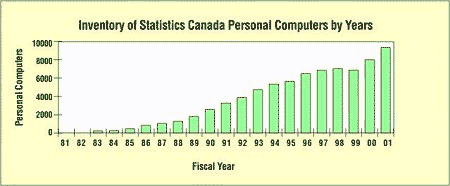
A look at our past
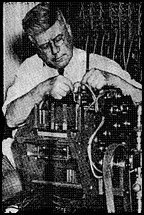 Resident inventor designs Bureau's mechanical tabulators
Resident inventor designs Bureau's mechanical tabulators
Fernand Bélisle, born in the Eastern Townships of Quebec in 1889, became a legend in the DBS [Dominion Bureau of Statistics] as a mechanical genius. The 1941 administrative report of the Dominion Statistician [R.H. Coats] cited Bélisle as the developer of the Pantograph machine, used since 1911 for punching cards; and as the inventor of the electric gang-punch machine used so effectively in the 1931 Census, and of the compressed-air sorter-counter machine that "tabulated a record amount of information in the 1941 Census." Referring to the compressed-air tabulator, Coats told the 1940 Conference on Canadian-American Affairs that the DBS "has developed a census machine which is the envy of the world." Apart from a couple of early breaks in service, Bélisle worked for the Bureau from 1911 until he retired in 1950. He died in 1963.
A general view of the IBM 705 III computer in 1969
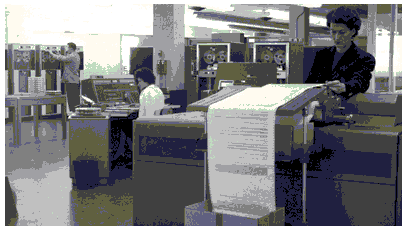
Vacuum tubes
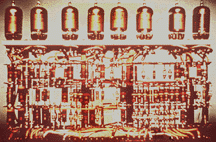
Microprocessor
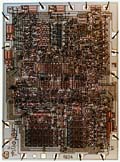
The first transistor
